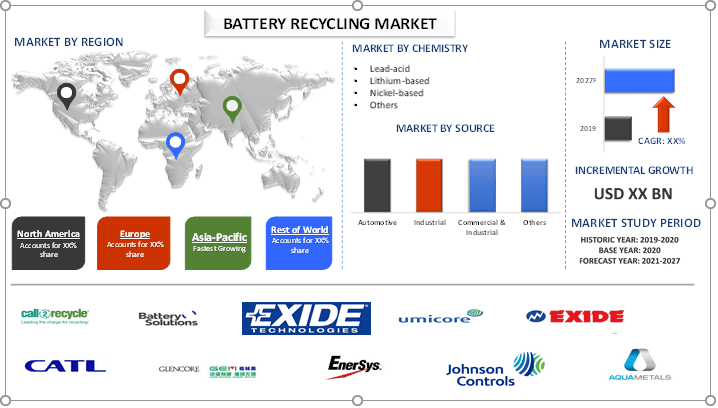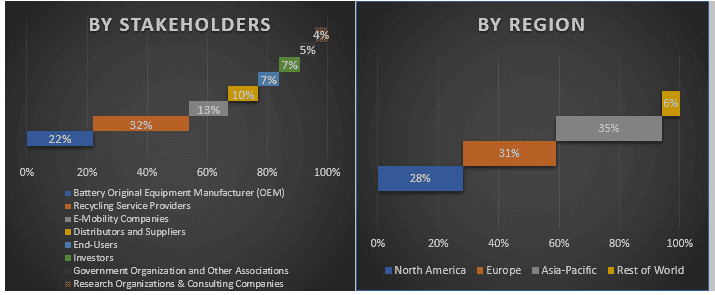- Home
- About Us
- Industry
- Services
- Reading
- Contact Us
Battery Recycling Market: Current Analysis and Forecast (2021-2027)
Emphasis on Chemistry (Lead-Acid, Lithium-Based, Nickel-Based, Others); Source (Automotive, Industrial, Consumer & Electronics, Others); Region/Country

The global battery recycling market was stood around US$17 billion in 2020 and is expected to showcase the growth rate of more than 6% during the forecast period (2021-2027). With increasing demand of batteries, the concern among environmental bodies is growing to make batteries sustainable after its end life. Moreover, in many countries, it is illegal to dispose the batteries in the trash as batteries consist of corrosive materials and heavy metals that can contaminate the environment. Therefore, recycling of batteries is required to make battery industry value chain profitable and eco-friendly. However, currently, only a very limited number of batteries are recycled. For instance, in Australia, only 2-3% of li-ion batteries are collected and sent for recycling whereas in European union and the US, the recycling rate of li-ion batteries are below 5%. Currently, companies are mainly focusing on increasing production of batteries, increase battery longevity and charge capacity, and simultaneously reducing the cost of batteries and not in advancing the recycling process. Therefore, a great number of unrecycled batteries went through a high-temperature melting-and-extraction, or smelting, process. These processes are energy intensive and requires large capital and advance equipment’s. However, these processes are not capable of recovering all valuable materials therefore a proper recycling value chain is a need for a sustainable development.
Similar to most of the industry, COVID-19 had the negative impact on the battery recycling market. Since, recycling of batteries requires a fully efficient supply chain which had been disrupted in the light of COVID-19. Further, in order to curtail the spread of disease, government across the globe, had taken several stringent measures like lockdown which has resulted in the factory shutdown or operating with reduced number of manpower thus resulted in the low productivity. Further, collection of battery is the first step of battery recycling process, however, due to the agitation of disease, consumers are not willing to go outside, which has affected the collection of batteries as well.
Insights Presented in the Report
“Amongst chemistry, lead-acid category dominated the market in 2020.”
Based on chemistry, the market is categorized into lead-acid, lithium-based, nickel-based, and others. Among these, lead-acid battery held the dominating share in the market. The market of lead-acid battery is matured and has well-established supply chain owing to which recycling companies are mainly engage in the recycling of lead-acid battery. Further, cost-effectiveness and high recyclable rates are some of other key attributable factors for its largest market share.
“Amongst source, automotive category dominated the market in 2020.”
Based on source, the market is categorized into automotive, industrial, consumer & electronics, and others. Among these, automotive held the considerable market share in 2020 owing to large and growing demand of automobiles and shorter average life of automotive batteries. Further, increasing adoption of electric vehicle would also increase the recycle activity in the industry.
“Asia-Pacific is likely to showcase robust growth during the forecast period”
For a better understanding of the market adoption, report provide detailed analysis for major region and countries including North America (US, Canada, Rest of North America), Europe (Germany, UK, France, Spain, Rest of Europe), Asia-Pacific (China, Japan, India, Australia, Rest of APAC), and Rest of World. Asia-Pacific is likely showcase significant growth during the forecast period owing to increasing sales of consumer electronics, growing automotive sector, rising investment in the recycling activities, and growing adoption of e-mobility. Some of the major companies profiled in the report includes Call2Recycle Inc., Battery Solutions LLC, Exide Technologies, Umicore N.V., Exide Industries Ltd., Contemporary Amperex Technology Co. Ltd., Gem Co. Ltd., Enersys, Johnson Controls International plc, and Aqua Metals Inc.
Reasons to buy this report:
- The study includes market sizing and forecasting analysis validated by authenticated key industry experts
- The report presents a quick review of overall industry performance at one glance
- The report covers in-depth analysis of prominent industry peers with a primary focus on key business financials, product portfolio, expansion strategies, and recent developments
- Detailed examination of drivers, restraints, key trends, and opportunities prevailing in the industry
- The study comprehensively covers the market across different segments
- Deep dive country level analysis of the industry
Customization Options:
The global battery recycling Market can further be customized as per the requirement or any other market segment. Besides this, UMI understands that you may have your own business needs, hence feel free to connect with us to get a report that completely suits your requirements.
Table of Content
Research Methodology for Global Battery Recycling Market Analysis (2019-2027)
Analyzing the historical market, estimation of the current market, and forecasting the future market of the Battery Recycling three major steps undertaken to create and analyze its adoption across the globe. Exhaustive secondary research was conducted to collect the historical market numbers and estimate the current market size. Secondly, to validate these insights, numerous findings and assumptions were taken into consideration. Moreover, exhaustive primary interviews were also conducted, with industry experts across the value chain of the battery recycling industry. Post assumption and validation of market numbers through primary interviews, we employed a bottom-up approach to forecast the complete market size. Thereafter, market breakdown and data triangulation methods were adopted to estimate and analyze the market size of segments and sub-segments the industry pertains to. Detailed methodology is explained below:
Analysis of Historical Market Size
Step 1: In-Depth Study of Secondary Sources:
Detail secondary study was conducted to obtain the historical market size of the battery recycling through company internal sources such as annual report & financial statements, performance presentations, press releases, etc., and external sources including journals, news & articles, government publications, competitor publications, sector reports, third-party database, and other credible publications.
Step 2: Market Segmentation:
After obtaining the historical market size of the battery recycling market, we conducted a detailed secondary analysis to gather current market insights and share for different segments & sub-segments for major regions. Major segments included in the report are by chemistry and source. Further regional and country-level analyses were conducted to evaluate the overall adoption of the battery recycling globally.
Step 3: Factor Analysis:
After acquiring the historical market size of different segments and sub-segments, we conducted a detailed factor analysis to estimate the current market size of battery recycling. Further, we conducted factor analysis using dependent and independent variables such as increasing stringent regulations related to battery recycling, large base of battery end users and limited life, increasing demand of batteries, growing concern among OEMs regarding circular economy, and limited availability and difficult extraction and processing of metals. A thorough analysis was conducted for demand and supply-side scenario considering increasing investment, top partnerships, merger and acquisition, business expansion, and product launches in the battery recycling industry.
Current Market Size Estimate & Forecast
Current Market Sizing: Based on actionable insights from the above 3 steps, we arrived at the current market size, key players in the global battery recycling market, and market shares of each segment. All the required percentage shares split, and market breakdowns were determined using the above-mentioned secondary approach and were verified through primary interviews.
Estimation & Forecasting: For market estimation and forecast, weights were assigned to different factors including drivers & trends, restraints, and opportunities available for the stakeholders. After analyzing these factors, relevant forecasting techniques i.e., bottom-up approach was applied to arrive at the market forecast to 2027 for different segments and subsegments across the major regions globally. The research methodology adopted to estimate the market size encompasses:
- The industry’s market size, in terms of value (US$) and the adoption rate of battery recycling across the major markets
- All percentage shares, splits, and breakdowns of market segments and sub-segments
- Key players in the battery recycling market in terms of products offered. Also, the growth strategies adopted by these players to compete in the fast-growing market.
Market Size and Share Validation
Primary Research: In-depth interviews were conducted with the Key Opinion Leaders (KOLs) including Top Level Executives (CXO/VPs, Sales Head, Marketing Head, Operational Head, and Regional Head, Country Head, etc.) across major regions. Primary research findings were then summarized, and statistical analysis was performed to prove the stated hypothesis. Inputs from primary research were consolidated with secondary findings, hence turning information into actionable insights.
Split of Primary Participants in Different Regions

Market Engineering
Data triangulation technique was employed to complete the overall market estimation and to arrive at precise statistical numbers of each segment and sub-segment of the global battery recycling market. Data was split into several segments & sub-segments post studying various parameters and trends in the areas of power requirement, power rating, mobility, and end-user.
The main objective of the battery recycling market study
The current & future market trends of global battery recycling were pinpointed in the study. Investors can gain strategic insights to base their discretion for investments from the qualitative and quantitative analysis performed in the study. Current and future market trends would determine the overall attractiveness of the market at a country level, providing a platform for the industrial participant to exploit the untapped market to benefit as a first-mover advantage. Other quantitative goals of the studies include:
- Analyze the current and forecast market size of battery recycling in terms of value (US$). Also, analyze the current and forecast market size of different segments and sub-segments
- Segments in the study include areas of chemistry and source
- Defined analysis of the regulatory framework for the battery recycling industry
- Analyze the value chain involved with the presence of various intermediaries, along with analyzing customer and competitor behaviors of the industry
- Analyze the current and forecast market size of the battery recycling for the major countries
- Major regions/countries analyzed in the report includes North America (US, Canada, Rest of North America), Europe (Germany, UK, France, Spain, Rest of Europe), Asia-Pacific (China, Japan, India, Australia, Rest of Asia-Pacific), and Rest of World
- Company profiles of the battery recycling market players and the growth strategies adopted by them to sustain in the growing market
Deep dive country level analysis of the industry
Related Reports
Customers who bought this item also bought










